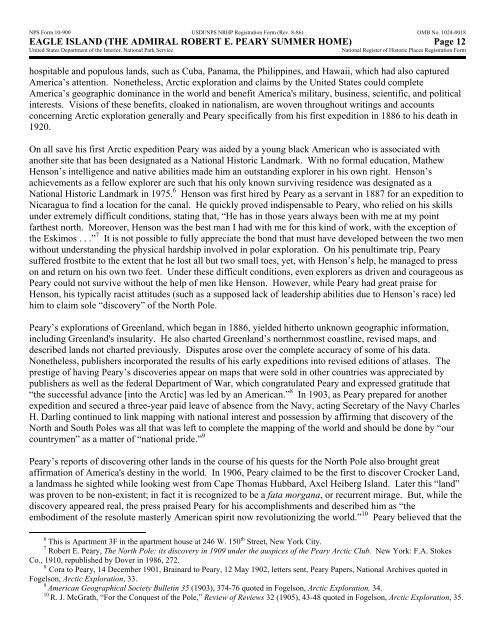Nomination - National Park Service
Nomination - National Park Service
Nomination - National Park Service
You also want an ePaper? Increase the reach of your titles
YUMPU automatically turns print PDFs into web optimized ePapers that Google loves.
NPS Form 10-900 USDI/NPS NRHP Registration Form (Rev. 8-86) OMB No. 1024-0018<br />
EAGLE ISLAND (THE ADMIRAL ROBERT E. PEARY SUMMER HOME) Page 12<br />
United States Department of the Interior, <strong>National</strong> <strong>Park</strong> <strong>Service</strong><br />
<strong>National</strong> Register of Historic Places Registration Form<br />
hospitable and populous lands, such as Cuba, Panama, the Philippines, and Hawaii, which had also captured<br />
America’s attention. Nonetheless, Arctic exploration and claims by the United States could complete<br />
America’s geographic dominance in the world and benefit America's military, business, scientific, and political<br />
interests. Visions of these benefits, cloaked in nationalism, are woven throughout writings and accounts<br />
concerning Arctic exploration generally and Peary specifically from his first expedition in 1886 to his death in<br />
1920.<br />
On all save his first Arctic expedition Peary was aided by a young black American who is associated with<br />
another site that has been designated as a <strong>National</strong> Historic Landmark. With no formal education, Mathew<br />
Henson’s intelligence and native abilities made him an outstanding explorer in his own right. Henson’s<br />
achievements as a fellow explorer are such that his only known surviving residence was designated as a<br />
<strong>National</strong> Historic Landmark in 1975. 6 Henson was first hired by Peary as a servant in 1887 for an expedition to<br />
Nicaragua to find a location for the canal. He quickly proved indispensable to Peary, who relied on his skills<br />
under extremely difficult conditions, stating that, “He has in those years always been with me at my point<br />
farthest north. Moreover, Henson was the best man I had with me for this kind of work, with the exception of<br />
the Eskimos . . .” 7 It is not possible to fully appreciate the bond that must have developed between the two men<br />
without understanding the physical hardship involved in polar exploration. On his penultimate trip, Peary<br />
suffered frostbite to the extent that he lost all but two small toes, yet, with Henson’s help, he managed to press<br />
on and return on his own two feet. Under these difficult conditions, even explorers as driven and courageous as<br />
Peary could not survive without the help of men like Henson. However, while Peary had great praise for<br />
Henson, his typically racist attitudes (such as a supposed lack of leadership abilities due to Henson’s race) led<br />
him to claim sole “discovery” of the North Pole.<br />
Peary’s explorations of Greenland, which began in 1886, yielded hitherto unknown geographic information,<br />
including Greenland's insularity. He also charted Greenland’s northernmost coastline, revised maps, and<br />
described lands not charted previously. Disputes arose over the complete accuracy of some of his data.<br />
Nonetheless, publishers incorporated the results of his early expeditions into revised editions of atlases. The<br />
prestige of having Peary’s discoveries appear on maps that were sold in other countries was appreciated by<br />
publishers as well as the federal Department of War, which congratulated Peary and expressed gratitude that<br />
“the successful advance [into the Arctic] was led by an American.” 8 In 1903, as Peary prepared for another<br />
expedition and secured a three-year paid leave of absence from the Navy, acting Secretary of the Navy Charles<br />
H. Darling continued to link mapping with national interest and possession by affirming that discovery of the<br />
North and South Poles was all that was left to complete the mapping of the world and should be done by “our<br />
countrymen” as a matter of “national pride.” 9<br />
Peary’s reports of discovering other lands in the course of his quests for the North Pole also brought great<br />
affirmation of America's destiny in the world. In 1906, Peary claimed to be the first to discover Crocker Land,<br />
a landmass he sighted while looking west from Cape Thomas Hubbard, Axel Heiberg Island. Later this “land”<br />
was proven to be non-existent; in fact it is recognized to be a fata morgana, or recurrent mirage. But, while the<br />
discovery appeared real, the press praised Peary for his accomplishments and described him as “the<br />
embodiment of the resolute masterly American spirit now revolutionizing the world.” 10 Peary believed that the<br />
6 This is Apartment 3F in the apartment house at 246 W. 150 th Street, New York City.<br />
7 Robert E. Peary, The North Pole: its discovery in 1909 under the auspices of the Peary Arctic Club. New York: F.A. Stokes<br />
Co., 1910, republished by Dover in 1986, 272.<br />
8<br />
Cora to Peary, 14 December 1901, Brainard to Peary, 12 May 1902, letters sent, Peary Papers, <strong>National</strong> Archives quoted in<br />
Fogelson, Arctic Exploration, 33.<br />
9<br />
American Geographical Society Bulletin 35 (1903), 374-76 quoted in Fogelson, Arctic Exploration, 34.<br />
10<br />
R. J. McGrath, “For the Conquest of the Pole,” Review of Reviews 32 (1905), 43-48 quoted in Fogelson, Arctic Exploration, 35.
















